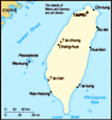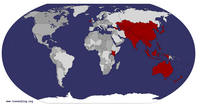Advertisement
Two weeks in Taiwan
Less than 24 hours after landing in Taiwan we were accompanying Will's uncle Paul to an aboriginal wedding in the Nantou mountains.
We travelled across Taichung (the city Will's uncle lives in) to a 7-Eleven to catch an organised minibus to the wedding along with some other guests. The atmosphere on the bus was a lively mix of South African, English and Canadian expats, who all teach English in local schools. The groom, a colleague of Paul's from Wales, was marrying a Taiwanese lady from an aborigine tribe in the Nantou mountains. We were the last to arrive and had to awkwardly squeeze through many large circular tables filled with hundreds of guests from the village to find some spare seats at the front. Quickly seated and with the attention diverted away from us, the speeches (all in Mandarin) began on stage. During the speeches an assortment of food continued to arrive at our table including sushi, followed by a whole boiled chicken (head and feet included), black rice, coconut cakes and other traditional foods. The food and drink(s) supply was endless and 10 courses later we were sufficiently stuffed. Throughout
the meal karaoke was performed by various friends and family of the bride and groom including a proposal followed by a very awkward duet from the newly engaged couple.
The meal drew to a close and the remaining party relocated to the family's house where the drinking and karaoke continued on late into the evening. It's tradition at an aborigine wedding for the groom to donate a pig as a sacrificial offering to the bride's family to be spit roasted whole and eaten at the wedding. Later on, I saw the head and the remaining parts of the body slumped in the kitchen sink at the back of the house, a pretty ghastly sight after a few drinks! Eva, the bride, tried dragging us up to sing a karaoke song but things were dying down so we made a lucky escape to a guest house down the road.
Christina (Paul's wife) and Eddie (Will's cousin) took us to the Michelin star restaurant - Din Tai Fung, famous for XiaLongBao (pork dumplings). The ordering process in Taiwan is different to the rest of Southeast Asia. You take a sheet, tick the boxes for the appropriate
dish along with the quantity and then hand the piece of paper in and wait for your food to be delivered, similar to ordering a product in Argos without the "number 67 to your collection point please" announcement! The dumplings arrived freshly steamed in their bamboo baskets. Having pre-made a soy sauce with added vinegar and ginger, Eddie explained how to dip the dumpling in the sauce, place it on the spoon and create a hole using the chopsticks to release the juicy insides. As promised the dumplings were juicy and flavorsome, noticeably better than any others we had tried since arriving in Taiwan. As we left the restaurant we could see through large glass panels to the kitchen where the chefs were preparing the food. The dumplings are made using precisely 5 grams of dough stuffed with 16 grams of pork filling and pinched exactly 18 times to form the pleated swirl seal at the top - the more pleats the better the quality.
That evening Eddie took us to his university - Feng Chia, where he studies architecture. He showed us around the complex and some models he and other students had designed and built
for their exams. One innovative model we saw was a farm built vertically in levels, similar to a car park to reduce the space used horizontally. We visited the night market located next to the university to get some dinner from the street stalls. We tried the Taiwanese equivalent of a hot dog - a pork sausage wrapped in a slightly bigger and thicker sticky rice sausage then char-grilled. Eddie also introduced us to a popular Taiwanese drink, papaya milk - a delicious blend of papaya fruit, milk, sugar and condensed milk. Being situated next to the university the market had a cool student vibe with arcade type games and dance music booming from the clothes shops.
Christina and her friend kindly took us for a day trip to Lugang - an old port town 25km west of Taichung. We visited Lung Shan temple, built in 1786 for the steadily increasing number of Buddhists immigrating to the area. The ceiling and walls were made from intricate wooden carvings covered in faded paintings emphasising the age of the temple. The aged building along with the upturned Chinese roof was unlike the more modern temples we had seen in
Thailand and other parts of Southeast Asia. Inside were panels of tiny lights with names assigned to each individual one. Once a year people donate money, in exchange for a light and the promise to give them luck and keep them safe. We visited an empty mansion, now a museum, with some of the original furnishings including an elaborate carriage that would have been used to transport the wealthy families. We finished off the day in a handmade Japanese lantern shop filled with colourful lanterns hanging from the ceiling. On our way back we stopped for tea with Christina's brother and his wife. They generously shared their expensive tea leaves from the local plantation while showing us how they make fresh tea in Taiwan without using milk or sugar. We tried two types, one new and a vintage 20 year old tea. I preferred the, ess bitter, older tea.
With the exception of 7-Eleven and Family Mart convenience shops, the majority of food is still bought from traditional local markets like the one Christina took us to. Like other asian markets there was a wide assortment of fruit, vegetables, meat and fish as well as some more
unusual things like black chicken. The silkie chicken is a special breed with black skin and bones, very much a delicacy in China for its gamey taste. Taiwan, like the rest of Asia are very resourceful and every part of the animal can be found at the market and in many restaurants. Will tried a beef tendon soup on a recommendation from another diner, the texture was soft and gelatinous.
Paul invited us to Shin Min high school where he teaches English. He welcomed us into his class of 50 seventeen year old students who seemed very excited to see us. Luckily being the end of term, lessons were relaxed and they were eager to watch Will's magic tricks and take photographs with us. The second class was smaller and more intimate. The students were keen to practice their English, asking about our travels and our lives in England. They wrote out our names in Mandarin (the most commonly spoken language) using the closest sounding Chinese characters - mine being phonetically pronounced 'Char Lur' and translating as Snow Happy and Will's being pronounced 'Way Lian' and translating to Powerful Curtain!
Excellent local transport is
provided by the Taiwanese goverment. The Ubike (bicycle) is free for 30 mins and the buses are free for the first 8km, making it cheap and convenient for getting around the major cities. The MRT in Taipei is modern and clean, a bit of a difference to the London Undergound. People form an orderly queue to get on, there is a strict no food or drink policy and even though there are crowds of people the atmosphere is calm and quiet. The most difficult thing for me to adapt to was patiently waiting before crossing every road. Like the MRT everyone queues up and waits quietly in the shade for what can be up to to five minutes for all the traffic lights to change. The most striking thing for me is that no one visibly enforces these rules, everyone seems to follow it out of pride to keep their city in order.
Taipei City, the capital of Taiwan is similar to London and other major capitals. The streets are bustling with people, designer shops, high end restaurants and advertising bill boards smothering highrise buildings. We sat and listened to a violinist busking on the streets, the
atmosphere reminded me of Christmas with blue fairy lights twinkling in the trees.
The following morning, on our way to the train station Eddie and Will stopped to try their luck on some Taiwanese scratchcards, winning a large sum of 200TWD (just £4 when converted) to quickly be reinvested it in two more losing tickets! We arrived at Yehliu, a north coast port town still functioning as a fishing hub and home to a geopark. This sea-eroded landscape is covered in mushroom shaped rocks with a honeycombed surface, pot holes and deep crevices. Individual rocks have been named such as the Queen's Head rock and Tofu rock along with many others. We walked through the park to the furthest point with breathtaking views of the sea in the glorious sunshine. We returned that evening to Taipei for a traditional hot pot at a famous Taiwanese restaurant. A selection of ingredients arrived raw at the table which we then cooked ourselves in a broth heated in the middle of the table. We found it a very sociable and enjoyable dinner experience as well as it being great tasting food.
We took a train from Taipei
to Taroko Gorge on the east coast of Taiwan. We hopped on the organised bus that transported us through the national park and dropped us off to walk along the Swallow Grotto trail - a marble gorge with rapids running through the middle. We then jumped on a bus through the national park to Tianxiang. We found an opening on the roadside enabling us to climb down the rockside, across the grey sand and down to the rapids.
On our return to Taipei we visited Ice Monster, a famous ice dessert restaurant. This prestigious restaurant has a continuous queue waiting at its door, even at 10.30pm when we arrived, as well as a minimum spend per order. I can imagine these extravagant mango and ice concoctions would be very popular in London, if they're not there already!
We returned to Taichung for our last few days with Will's family before our next stop.. The Philippines
https://www.claritycounsellingnorthernbeaches.com
Advertisement
Tot: 0.159s; Tpl: 0.013s; cc: 7; qc: 44; dbt: 0.0838s; 1; m:domysql w:travelblog (10.17.0.13); sld: 1;
; mem: 1.2mb




















